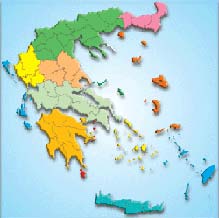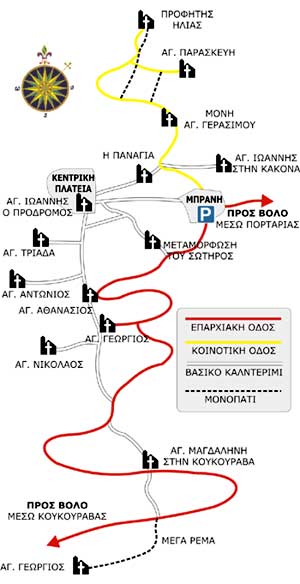
Please click on the map,
the region you want to visit |
|
|
|
|
| |
|
 |
Makrinitsa...
the "balcony" of Peleon |
|
The main road reaches Makrinitsa through Portaria, but the recent years, a road was dug through Koukourava. Both roads lead to Piazza of Brani and from there a steep serpentine road continues to the monastery of St. Gerasimos and above up to the land and to the community forest.
But the internal traffic of the settlement was done for a long time and is still done through a key plank path that crosses over the village, from the highest district of Kakounas to the lower district of Koukourava, while a secondary system of paved roads branching out in all directions so someone can reach the most remote village houses.
 The stone paths, manufactured with stones wedged in soil, are durable in time and in a distance of stride, the protruding stones help the wayfarers and the animals which are used for transport, to pass.
Feature of the town is the large number of fountains (over 50) that are in the course of the cobbled streets and are used as a point for staging for the walkers and as water supply of homes since then there was no corresponding network.
The waters from the fountains fleeing into grooves running next to the streets so the passer who walks in the village can hear the sound of the water next to him.
Another remarkable type of constuction of the traditional architecture Μακρινίτσας of Makrinitsa are the stone bridges which someone can find in the village, in front of the church of St. John the Theologian, at the district of Kakouna but also in nearby locations, as in Karya in Lestiani , Loziniko and Alevizos.
|

 |
TOUR IN CHURCHES
AND MONASTERIES

| Makrinitsa has several churches built from 1600 to 1800 and all are basilicas, aisle or three-aisled, without dome, built with stone, with wooden roofs and overlap by slabs. |

 |
The main current church, the Cathedral, is the Virgin Mary (The Assumption) that it was built in 1767 just west of the monastery of "Oxias Episkepseos" which collapsed in a landslide, so to the new church incorporated the components that could be used (mainly stone reliefs, columns, marble parts etc). Inside the church is placed a white marble sculpture representing the Virgin Mary standing in a praying position as the Lady of the width of Heaven.
On the west side of the court of Virgin Mary there is a two storey building, the "Despotic",
πwhich served as a residence for the bishop during his visits to Makrinitsa.
Below the church of Virgin Mary, on the south side of the courtyard, there is a two-storey chapel known as "Secret School" with the "All Saints"chapel upstairs and Saint John downstairs dated in 1743.
In the centre of the square, is the small but charming church of St. John the Baptist (1806), built with marble slab that is divided into layers with bricks and has an interesting sculptural decoration in the sanctuary.
The magnificent church of Saint Athanasios has an inscription where it is stating that it was restored for a third time in 1792, but the roof has collapsed and its restoration is pending.
Just below is the church of St. George with an inscription that indicates the year of 1766 and at a short distance to the stream of Sarakinos, there is the smallest church of St. Nicholas (1787).
At the district of Koukourava overlooks the majestic church of St. Mary Magdalene. Next to elementary school of Makrinitsa is the Holy Trinity, with frescoes by the painter Pagonis 1836, while below the Museum of Folk Art is the Church of the Transfiguration.
At the district of Kakouna there is the church of St. John the Theologian and higher, at the highest point of Makrinitsa, there is the Holy Monastery of St. Gerasimos (1795).
Churches are also located in other regions around Makrinitsa as the chapel of St. George opposite to Koukourava, over the Grand Stream, where you can see the whole Makrinitsa, the Temple of Pr. Elias and of Saint Paraskevi (1793) up to the road, to the lands of the village and farther, behind the mountain, there is the Virgin Lestiani, the nowadays abandoned Monastery of Souvria that was built in 1627, and also beyond, over the sea, there is the operating monastery of Flamoyria founded between 1595 and 1602. |
 |
Accommodation proposals, entertainment and shopping in Makrinitsa |
|
|
|